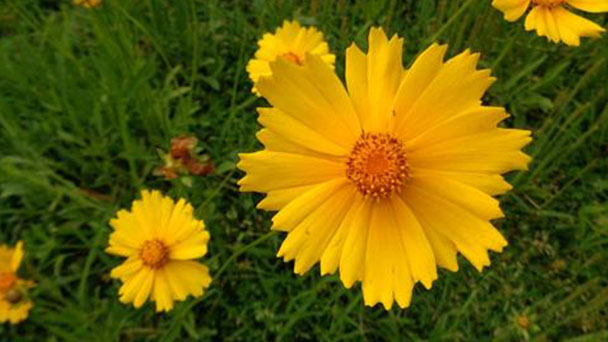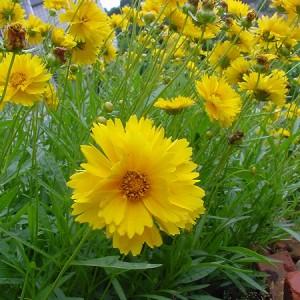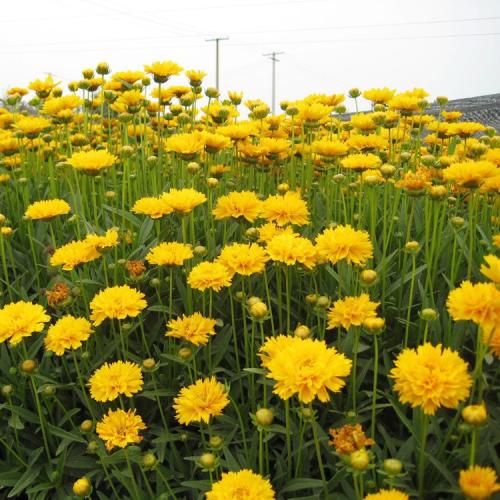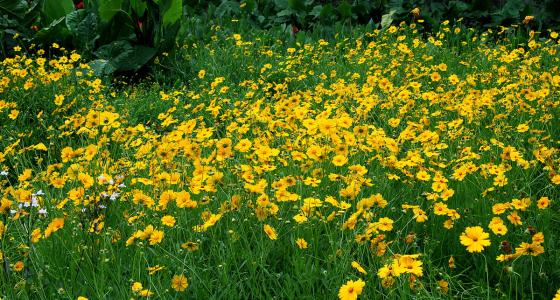Coreopsis profile
Written by Maggie
Apr 09 2021

Coreopsis is a genus of annual and perennial herbs in the composite family. Most species are native to eastern North America. Coreopsis was first introduced by the British in Shandong Peninsula and is now growing in many parts of the country. Coreopsis is a member of the Compositae family. The main species are, Coreopsis, large-flowered Coreopsis, large-flowered Coreopsis, and ring-leaf Coreopsis. The Latin name for the little Coreopsis is Coreopsis tinctoria; The Latin name for large Coreopsis is C. Rosa.
Coreopsis picture

Coreopsis info
| Botanical Name | Coreopsis spp. |
| Common Names | Coreopsis, tickseed, calliopsis |
| Plant Type | Perennial, annual |
| Sun | Full |
| Hardiness Zones | 3–10 (USDA) |
| Flower color | Red, orange, yellow, pink, white |
| Native Area | North America, Central America, South America |
| Mature size | 1.5–4 ft. tall and wide (varies by species) |
Morphological characteristics of Coreopsis
Coreopsis is a perennial herb with persistent roots. The golden brown Coreopsis, which can reach a height of 3 feet (90 centimeters), is the most popular variety. Coreopsis leaves divide into narrow segments, like fern leaves, often opposite, rarely alternate, entire, lobed, or cleaved. The corolla is yellow or purplish red with a golden brown center. Flowers are solitary or sparsely panicle, involved in two rows, 3 in each row, base connate.1 row of ligulate flowers, broadly ligulate, yellow, brown, or pink. Tubular, yellow to brown flowers. Coreopsis flowers are about 3 inches (7.5 centimeters) wide, with yellow disks and dentate umbels that are yellow, white, pink, or purplish red. Flowers are in season from July to October and grow best in dry and sandy soil. Large Coreopsis (Tickseed) is a wild Coreopsis with pink umbellate corolla and leaves that resemble grass.
Ecological habits of Coreopsis
Coreopsis are cold and drought-tolerant, not strict with soil, light-loving, but semi-shade tolerant, adaptable, and resistant to sulfur dioxide.
How to grow and care for Coreopsis
Light
Coreopsis flora will develop and bloom high-quality in full sun, which means at least six hours of direct daylight on most days. They can additionally develop in partial sun, however the vegetation may be lankier and no longer flower as profusely. However, in climates with very warm summers, the vegetation regularly chooses some afternoon shade.
Soil
These vegetation thrive in well-draining loamy or sandy soil with a pretty impartial soil pH. However, most coreopsis types are very handy to develop and don't seem to be specific about soil best or soil pH, as lengthy as they don't seem to be waterlogged. Heavy, moist clay soils ought to be amended with compost to assist drainage.
Water
New coreopsis flowers want ordinary water to preserve the soil evenly moist (but no longer soggy) till they are established. After their first year, these plant life have top drought tolerance, however they may bloom most prolifically with everyday watering. Water deeply every time the soil is dry about an inch down. Early morning watering is best, so the leaves have a risk to dry for the duration of the day.
Temperature and humidity
Coreopsis vegetation likes heat temperatures between roughly 70 and eighty levels Fahrenheit all through the day and 50 to 60 tiers Fahrenheit at night. More than a few species have different ranges of bloodless tolerance. Humidity usually is not a difficulty for these vegetation as they have right air circulation and suitable watering and drainage.
Fertilizer
Fertilization usually isn't always crucial until you have very terrible soil. Too an awful lot of fertilizer can genuinely promote immoderate foliage increase and avoid flowering. To supply your flowers a boost, combine a little compost into the soil in the spring.
How to grow coreopsis from seed
Many coreopsis types can be grown from seed and regularly will reseed themselves in your garden. Start seeds indoors six to eight weeks earlier than your area's projected closing frost date, or at once plant seeds in your backyard after your ultimate frost. Plant the seeds roughly half of an inch deep, and preserve the soil gently, moist and warm. Seedlings ought to emerge in about two to three weeks. Put indoor seedlings by using a sunny window, and proceed to maintain the soil gently moist. Indoor seedlings will want to be slowly acclimatized to the outside by using taking them outdoors for longer stretches every day for about a week. Then, they’re prepared to be planted in the garden.
Coreopsis propagation
Coreopsis is a perennial herbaceous plant that is cold-tolerant and drought-tolerant. It is light tolerant, but semi-shade tolerant, adaptable, and resistant to sulfur dioxide.Coreopsis is easy to grow and can reproduce on its own. In production, sowing or division propagation is adopted, and cuttage propagation can be carried out in summer.

Disease control in Coreopsis
The main diseases of Coreopsis are blight disease and brown spot disease. Prevention and control methods: one is to remove the sick leaves, pull out serious strains. Take it out of the field for destruction; The second is drug control, which can kill spray, every 5 ~ 7d once. Spray 3 times. Remove the nozzle of the sprayer with a solution of 1000 times 75% phoxim emulsion. In the evening spray insecticide on the base of the stem to control ground tiger. It is better to control other pests by using the insecticides such as quick-killer, dichlorvos and dichlorophenol.
Species taxonomy of Coreopsis
Coreopsis basalis
The coreopsis plant height is 30 to 90 cm, the whole plant sparsely grows hairy, the whole plant margin is lobed, the stem leaves are long spatulate or lanceolate, the stem leaves are 3 to 5 lobed, the head inflorescence diameter is 6 to 7cm, long pedunculate, golden flowers.
C grandiflora
Whole plant slightly hairy, branched, basal leaves lanceolate, entire, upper leaves 3 to 5 deeply lobed.Inflorescences 4 -- 63cm, involucre subequal in inner and outer rows.8 lingulate flowers, yellow 1~2 long?5cm, terminal 3-lobed, tubular flowers also yellow.
C lanceolata
Glabrous or sparsely hairy, leaves many fascicled at base or few opposite, leaves few on stem, head flowers about 5 -- 6cm in diameter, outer involucre often shorter than inner, ligulate flowers 8 yellow, tip 2 -- 3 lobed.The tubular flowers are yellow .Leaves CoreopsisCoverticillata@ glabrous, less branched, impeller sessile palmately 3-lobed, lobes finely lobed, tubular flowers yellowish to yellow-green.
Coverticillata
Glabrous, little branching, impeller unborn sessile palmately 3 deep lobes, lobes and fine lobes, tubular flowers yellow to yellow-green.
Coreopsis region of distribution
Coreopsis is native to the southern United States. One of the early alien species, once in Henan and other parts of the small outbreak.
Coreopsis uses
Medical use
Coreopsis has little medicinal value, but it should not be ignored. It has a sweet, pungent, bitter taste, and is slightly cold. Coreopsis can enter the liver and lung meridian and help to disperse wind and heat.Also can be used at the eye red swelling pain caused by irasceration, wind heat, liver and kidney deficiency or myopia, night blindness, etc. Coreopsis also has the role of Qingrejiedu, can be used for boils swelling poison, the usual dosage is 10~15 grams, water decocted. But Qi deficiency stomach cold, food less diarrhea should be used with caution.
Coreopsis garden use
Coreopsis is native to the eastern part of the United States, cold, heat resistant, extensive growth, Jiangnan often flows for the wild ground. The double species need to propagate by division. The flowers are golden and gorgeous. The head is golden yellow. Flowering in summer and autumn.

Latest Updated
- Benefits of Bugleweed - 7 Science-backed Health Benefits
- Bugleweed Dangers & Side Effects - Is It Poisonous?
- How to Plant Evergreen Trees - What You Should Know
- When to Plant Evergreens - Grow Guide for Evergreen Trees
- 12 Wonderful Evergreen Shrubs for Your Garden
- 12 Popular Evergreen Plants with Pictures for Beginners
- When And How To Prune A Lilac Bush Like a Pro
- How to Grow & Care for Lilac Vine (Hardenbergia Violacea)
- Japanese Lilac Tree (Syringa Reticulata) Care & Propagation Guide
- Shumard Oak Pros and Cons - What to Know
Popular Articles
- Winter maintenance of Antirrhinum Majus
- How to Grow Terminalia Mantaly Tree
- How to Grow and Care for Crossostephium Chinense
- How to grow Antirrhinum Majus in spring
- Peristeria Elata (Dove Orchid) Profile: Info & Care Guide
- Underwatered Snake Plant (Sansevieria Trifasciata) - Signs And How To Fix
- How to Care for Brazilian Jasmine Plant (Mandevilla Sanderi)
- How to Grow & Care for Graptopetalum Purple Delight in Summer
- Rosa Chinensis (China Rose): Plant Growing & Care Tips
- How to Care for Baby Sun Rose (Aptenia Cordifolia)